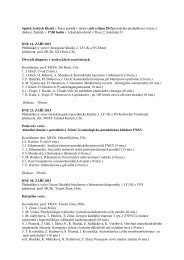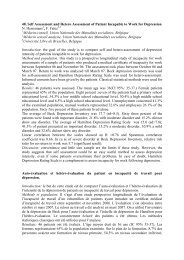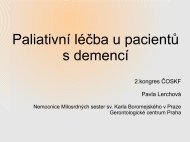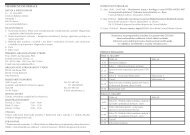ABSTRACTS â ORAL PRESENTATIONS - AMCA, spol. s r.o.
ABSTRACTS â ORAL PRESENTATIONS - AMCA, spol. s r.o.
ABSTRACTS â ORAL PRESENTATIONS - AMCA, spol. s r.o.
You also want an ePaper? Increase the reach of your titles
YUMPU automatically turns print PDFs into web optimized ePapers that Google loves.
P65. OVULATION STIMULATION PROTOCOLS UTILIZING GNRH-ANTAGONIST/HCG,<br />
PROMOTE CYTOTOXIC CELL POPULATIONS, PREDOMINANT IN PATIENTS WITH<br />
EMBRYO IMPLANTATION COMPLICATIONS<br />
Jan Svoboda 1 *, Zaneta Ruzickova 1 , Lucie Cuchalova 2 , Milena Kralickova 3 , Jitka Rezacova 4 ,<br />
Milena Vrana 5 , Anna Fiserova 1 , Jan Richter 1 , Jindrich Madar 4<br />
1<br />
Laboratory of Natural Immunity, Department of Immunology and Gnotobiology,<br />
Institute of Microbiology, ASCR v.v.i., Prague, Czech Republic, E-mail: svoboda@biomed.<br />
cas.cz<br />
2<br />
Institute of Macromolecular Chemistry, Academy of Sciences of the Czech<br />
Republic, Prague, Czech Republic<br />
3<br />
Department of Histology and Embryology, Faculty of Medicine in Pilsen, Charles<br />
University in Prague, Pilsen, Czech Republic<br />
4<br />
The Institute for the Care of Mother and Child, Prague, Czech Republic<br />
5<br />
The Institute of Hematology and Blood Transfusion, Prague, Czech Republic<br />
Objective: Gonadotropin-releasing hormone (GnRH) antagonist combined with<br />
the human chorionic gonadotropin hormone (hCG) is commonly used in assisted<br />
reproduction techniques (ARTs) to induce controlled ovarian hyperstimulation (COH)<br />
and to synchronize oocyte maturation. While hCG is known to have immunomodulatory<br />
properties, we aimed to assess its effect on immunological changes, with respect to<br />
HLA-G binding receptors and embryo implantation success.<br />
Design: The study involved 103 subjects, including patients undergoing COH protocols<br />
(n=66), divided on the basis of the pair’s fertility disorder (FD) causes (female FD, n=29;<br />
male FD, n=37), and age matched healthy women (n=37). The relative distribution of T<br />
cell (CD3+/CD4+, CD3+/CD8+) and NK cell (CD56 bright /CD16- , CD56 dim /CD16+) populations<br />
was evaluated together with HLA-G ligands KIR2DL4 and LILRB1 expression by flow<br />
cytometry in the peripheral blood of all subjects, as well as in patient follicular fluids.<br />
Results: Both groups of patients exhibited a significant decrease of their CD4/CD8 index,<br />
a down-modulation of LILRB1-positive CD8 T cells, and increased KIR2DL4-positive NK<br />
cell distribution, when compared to the healthy donors. These cell population levels were<br />
associated with failed embryotransfers in higher incidence. We attribute these changes<br />
to the COH protocol, since the only significant change between the patient groups was in<br />
the number of cytotoxic CD56 dim NK cells (elevated in the female FD group). Patients with<br />
male FD causes, having an above-average CD4/CD8 index (≥3.17) and below-average<br />
KIR2DL4+/CD56 bright NK cell levels(≤13.3%), exhibited higher embryo implantation rates.<br />
Conclusion: The GnRH antagonist/hCG protocol promotes CD3+/CD8+ and KIR2DL4+ NK<br />
cell levels, more abundant in subjects with lower implantation rates, and thus decreases<br />
the embryotransfer success in otherwise fertile women.<br />
Acknowledgements: This work was supported by a Grant Agency of the Ministry of<br />
Health of the Czech Republic grant [NR/9135-3].<br />
166 Analytical Cytometry VII








